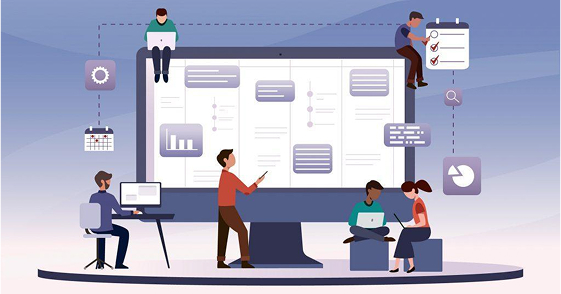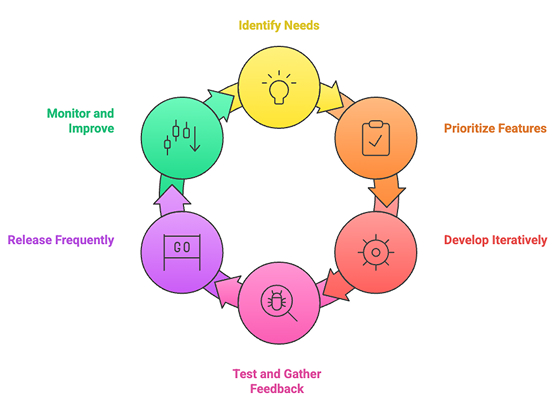
Software development teams always seek ways to deliver high-quality products faster and more efficiently. Lean software development is a modern approach many teams adopt to maximize value while minimizing waste.
What is Lean Software Development?
Lean Software Development (LSD) is an Agile-based approach focused on improving efficiency, reducing waste, and maximizing value in software development. Unlike traditional methods involving heavy documentation and rigid structures, lean encourages flexibility, learning, and rapid delivery.
Lean Software Development Principles
Lean software development consists of seven core principles that guide teams toward efficiency and high performance:
1. Eliminate Waste
Developing features that users don’t need or waiting for manual approvals can slow down delivery.
Common types of waste in software development:
- Unnecessary code/features
- Delays in approvals
- Knowledge silos
- Context switching
- Defects and rework
2. Build Quality
Quality should never be an afterthought. Lean promotes integrating quality practices from the beginning.
Key practices to build quality in:
- Test-driven development (TDD)
- Continuous integration (CI)
- Pair programming and code reviews
- Automated testing
3. Create Knowledge
Software development is a knowledge-driven field. Teams should constantly learn, experiment, and share insights to improve their skills with:
- Retrospectives
- Knowledge sharing sessions
- Experimentation
- Documentation
4. Defer Commitment
Lean encourages teams to delay irreversible decisions until they have enough information. This reduces risk and keeps the project adaptable.
How to defer commitment:
- Feature flags
- Delay technology choices
- Modular architecture
- Flexible backlogs
5. Deliver Fast
Speed is crucial in modern software delivery. By breaking work into small, manageable tasks, teams can quickly release features and get feedback.
Techniques to deliver fast:
- Agile iterations and sprints
- Continuous deployment (CD)
- Cross-functional teams
- Prioritize high-impact features
6. Respect People
Lean recognizes that people are the most important asset in software development. A motivated, empowered team will always outperform a team that is micromanaged or undervalued.
How to build a culture of respect and trust:
- Allow teams to make decisions
- Encourage collaboration
- Maintain work-life balance
- Create psychological safety
7. Optimize the Whole Process
Rather than optimizing individual tasks, Lean focuses on improving the entire system to deliver value smoothly from start to finish.
How to optimize the entire value stream:
- Identify bottlenecks
- Reduce handoffs
- Ensure smooth communication
- Use end-to-end metrics
The Lean Software Development Methodology
The lean software development methodology does not have a strict set of rules. It is a mentality and behavior set that changes depending on the project and team. Lean software development frequently uses techniques like:
- Value stream mapping : The complete development process must be visualized to find resource wastages and bottlenecks.
- Kanban boards : Kanban helps maintain a smooth workflow by visualizing tasks, limiting work-in-progress (WIP), and reducing context-switching.
- Minimum viable product (MVP) : Lean promotes creating the most essential product that can be released to get user feedback.
- Continuous delivery : Frequent releases guarantee shorter time-to-market and rapid feedback loops.
- Just-in-time development : Teams develop features just-in-time based on actual demand, preventing unnecessary work and reducing bottlenecks.
Lean Management in Software Development
Lean management software development applies management practices that encourage a culture of continuous improvement, ownership, and accountability.
Managers in lean environments are not traditional supervisors. Their role is to remove obstacles, foster collaboration, and support team growth. They mainly focus on:
- Supporting autonomy while ensuring alignment with business goals.
- Encouraging regular feedback from customers and stakeholders.
- Promoting problem-solving at all levels.
- Monitoring metrics like lead time, cycle time, and throughput rather than vanity metrics.
By implementing lean management principles, software teams can avoid typical issues like micromanagement, inflexible procedures, and disengaged leadership.
Lean Software Development Life Cycle

The lean software development life cycle is not vastly different from the traditional one. However, it strongly emphasizes flexibility, iteration, and feedback. Here’s how it generally flows:
1. Idea and Discovery Phase
Start by identifying customer needs and mapping the value stream. Clearly define the problem, set hypotheses, and establish success criteria.
2. Planning Phase
Prioritize features based on customer value. Apply the MVP mindset to focus on the most critical features first.
3. Development Phase
Include tiny, gradual cycles. Continuous integration (CI) and test-driven development (TDD) guarantee quality.
4. Testing and Feedback Phase
Constant testing is essential. Automated tests, code reviews, and peer feedback help to “build quality in.”
5. Release Phase
Lean software development favors minor, frequent releases over big, risky ones. The earlier the product gets into users’ hands, the faster you can learn.
6. Maintenance and Improvement Phase
Monitor performance, user input, and emerging requirements. Frequent retrospectives promote continuous improvements, streamline the procedure, and eliminate waste.
By adopting a lean perspective, teams can preserve agility and customer focus throughout the software life cycle.
Conclusion
Lean software development aims to deliver maximum value with the lowest resource waste. By following lean software development, software development teams can boost productivity, enhance product quality, and meet customer demands more quickly. Since we are in the world of rapid digital enhancement, lean ensures that teams remain adaptable for new tech stacks, value-driven, and laser-focused.
